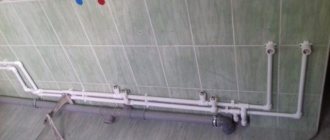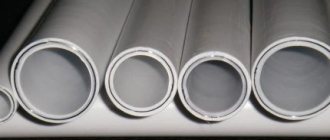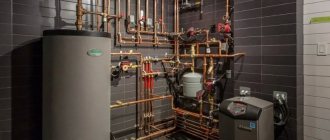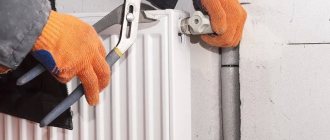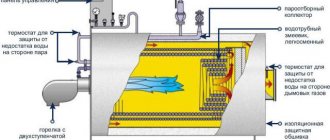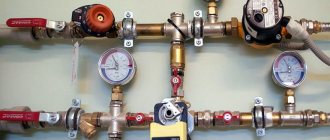assets/from_origin/upload/resize_cache/iblock/f50/600_450_2/f5027ddfcd78eb86d501536f41b52d29.jpg From this article you will learn:
- What heating schemes are used in the apartment?
- How do single-pipe heating schemes in an apartment differ from two-pipe heating schemes?
- What are the connection diagrams for heating radiators in an apartment?
Today, many apartment owners prefer autonomous heating. This heating system is more profitable and efficient than a centralized one. The principle of operation of autonomous equipment is as follows: the water entering the batteries is heated using a gas boiler. What heating connection diagrams in an apartment are used in practice? You will learn about this from our article.
Removing the old heating system
The next step after receiving permission to install your own heating is to dismantle the old heating. It should begin with agreeing on a further work plan with the housing office to disconnect your particular apartment from communications that run throughout the house.
- When performing work, strictly adhere to the received scheme. According to it, you have to cut out and block certain nodes that are directly connected to your home.
- If you act incorrectly, there is a huge chance of damaging the communication system of neighboring apartments, which threatens you with paying a large fine and restoration work at your own expense.
- First of all, it is recommended to dismantle the most basic elements of your heating system. To ensure that the central heating remains intact and at the same time has nothing to do with you, carefully cut out the part of the pipe leading to your apartment and install a new one in its place.
After you have managed to disconnect from the general system, start removing the old pipes and then replacing them with new ones. Be sure to get rid of the old wiring.
First start
The first start-up of a wall-mounted gas boiler must be carried out by a certified specialist. He will make all the necessary settings and check the operation of the system (more details: “How to start a gas boiler for the first time”). During the commissioning process, you have the opportunity to ask questions to a professional on the use of gas heating equipment. After completion of the commissioning work, a certificate is signed.
Thus, we can draw the following conclusion: the installation of wall-mounted gas boilers cannot be called simple. It requires relevant experience in the construction, installation and plumbing field. At some stages it will not be possible to do without the participation of specialists. But if you complete a number of steps yourself, then you will be able to save a lot of money.
Video examples of installation of a wall-mounted gas heating boiler:
Pipe routing
Depending on what designs and number of pipes were chosen, several types of wiring are classified: two-pipe, manifold, single-pipe and plinth.
At the same time, there are four ways to make a contour:
- Hidden method: pipes are placed in the walls;
- Open method: requires less money and time;
- Vertical method;
- Horizontal method.
Rules for installing a wall-mounted gas boiler
Stage one – wall mounting. The mounted gas boiler shown in the photo is mounted on a special bracket included in the kit with the device. But fasteners are not always suitable for it, and they often have to be purchased separately, taking into account the wall material on which they plan to place it. The fact is that the bracket must support the weight of the device and ensure its absolutely level position.
Pipe diagrams
Taking into account many factors, greater preference is given to single-pipe heating installation schemes in an apartment. This can be explained by both the installation speed and minimal costs.
The only thing is that the housing must initially be well insulated and then some of the disadvantages of a single-pipe system will be insignificant.
There are:
- Single-pipe horizontal system;
- Single-pipe vertical system;
- Leningradka.
In the case of a horizontal system, it is very suitable for small one-story houses or rooms with a relatively small area. To implement this, one pipe is laid in such a way that it closes into a ring around the perimeter of the house. In this case, the batteries are mounted strictly under the windows.
- Installation of heating batteries in an apartment is carried out using a cross connection. A lower connection is also possible, in which case the heat loss will be no more than 13%. The inlet is made from the top of the battery, the outlet from the bottom, which ultimately reduces heat loss.
- Vertical wiring is good for buildings with two or more floors. This method helps save on materials. The radiators are connected one after another using a side connection.
However, both vertical and horizontal systems have one common disadvantage - the very last battery in this system will always be the coldest, since the water supplied from the boiler reaches it last and has time to cool down a little.
The Leningrad system is considered the most advanced system, where the battery is connected to the pipeline in a special way, and taps are pre-installed on the inlets themselves to help regulate the volume of water.
How to choose a gas boiler
It should be noted right away that when we say gas heating, we still mean that the coolant is heated with gas. But water most often acts as a coolant. What parameters are used to choose gas boilers:
- By power. Low power (up to 65 kW) and medium power (up to 1700 kW) boilers are an ideal choice for the heating system of a private home. Under the Soviet Union, the power of a gas boiler was calculated using the formula 1 kW of power per 10 sq.m. area. However, for greater convenience, you can look at the boiler manufacturer’s website for special calculators for calculating the power of boilers, which take into account the characteristics of the region, the area of the house, the height of the ceilings, the number of floors and other parameters. It is better to add another 20% power on top in case of unforeseen situations.
- Boilers can be single- or double-circuit. Single-circuit units are used only for heating. If you also need to heat hot water, choose a double-circuit boiler. Immediately determine the need for hot water: if it is no more than 15 liters per minute with a temperature of up to 30C, a compact and convenient flow-type boiler will be a sufficient option. If hot water is needed in full, then the best option would be to buy a boiler with a boiler. The boiler can create a supply of hot water from 50l to 200l.
- Floor or wall. Floor-standing boilers are large in size, installed on the floor and can easily cope with the largest rooms. Typically, a separate small room is allocated for installing a floor-standing boiler. Modern wall-mounted boilers can cope with heating rooms up to 300 sq.m., are compact in size and can be installed directly in the kitchen on the wall.
- Burner type. A boiler with an atmospheric burner requires a traditional smoke exhaust system. These models are characterized by low efficiency, but also ease of operation and low cost. Units with a turbocharged burner have an electric turbine in their design for forced ventilation of the combustion chamber. Such systems have higher efficiency and are virtually independent of gas pressure differences.
Pipe selection
To save your own time and money, it is recommended that even when coordinating the project with the housing office, you think in advance which pipes will be used. Referring to the advice of experienced specialists, it is advisable to take pipes made of plastic or metal-plastic.
Copper, like steel, pipes are far from the best option for amateur beginners. They will require special handling, additional skills and, of course, special tools to be able to weld and cut parts.
- Plastic pipes are good because deposits do not appear inside them due to the quality of the water used.
- Low thermal conductivity allows you to provide rooms with heat for a long time.
- Pipes made from polypropylene can be called the best, based on the ratio of their price and quality.
Connecting them does not require any particularly complex skills, and it will not take much time to master the soldering iron needed to work with them.
Specifics of polypropylene strapping
A significant advantage of polypropylene pipelines is the ability to create a circuit of any complexity, which, in principle, is not of much interest to those who are piping a heating boiler with their own hands for the first time. The simpler the design of the future system, the easier it will be to implement the idea. And heating performance is inversely proportional to the degree of complexity: the simpler, the more effective. To make connections, a home craftsman can use both welding technology and fittings selected strictly according to the size of the pipes. True, with the slightest “movement” in the places where the fittings are installed, the system may begin to leak slightly.
Using polypropylene pipes, you can create heating circuits of any complexity, but it should be remembered that complexity complicates installation and reduces the efficiency of the heating system
It is desirable that the heating system being created has the smallest number of connections. If there is an opportunity to make a smooth transition, you should take advantage of it.
A polypropylene pipeline will operate without problems for 40 years, guaranteed by the manufacturer, and will perfectly withstand pressure values exceeding 25 bar. Without harming the structure of the material, coolant with a temperature of 95º can circulate through the pipes. However, there is a limitation that must be taken into account if piping a gas boiler is carried out.
The gas connection to the boiler must be rigid; construction requirements dictate the use of metal elements for connection and the use of paronite gasket
The gas supply to the boiler must have a rigid connection. Construction requirements recommend a metal pipe and connection to the heat generator through a metal pipe or “American pipe”. You can only use a paronite gasket. Rubber materials, fum tapes, and tow are prohibited. Paronite, obtained by vulcanization of a mixture of asbestos fibers, mineral fillers and rubber, holds its shape perfectly, ensures tightness and does not burn. Other gasket materials are prone to fire, and rubber sandwiched between elements can reduce the size of the gas passage. By reducing the diameter of the passage, the gas supply will be reduced and the boiler will not supply the required amount of heat.
Pipe laying methods
Pipe laying is done in two ways: open and closed. In the second case, the process takes more time, money and effort than the first.
However, with the closed method, you can avoid using additional space, because the pipes will be built into the walls.
The disadvantages of this option include the following: you do not have open access to the pipes. That is, in the event of any breakdown, you will not have the opportunity to immediately identify the problem area and will have to break the wall.
The open method is characterized by the ease of laying and installing pipes, the ability to carry out inspections if necessary, and then eliminate problem areas. But the obvious disadvantage is considered to be the reduction of space and the unaesthetic appearance of bare pipes.
